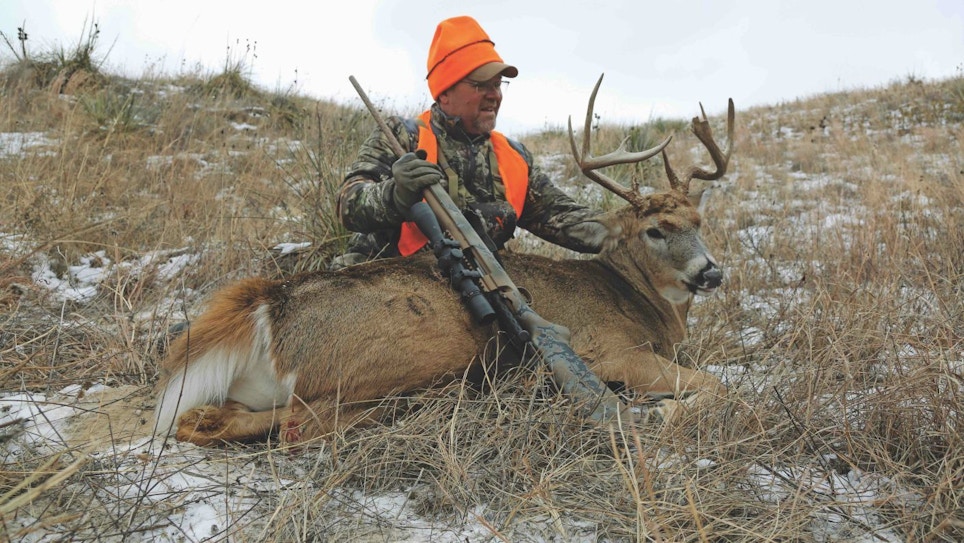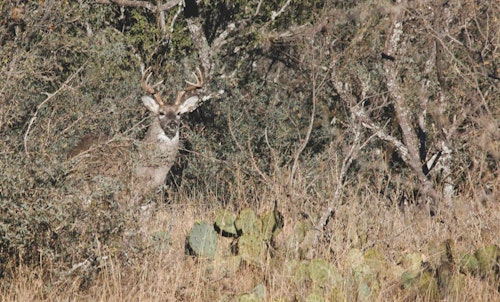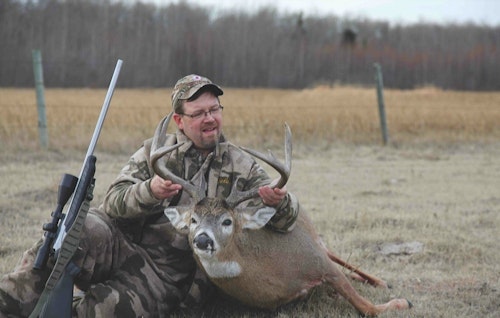
This Nebraska whitetail smelled the author and made a big loop through the hills. What the deer didn’t know was that it was being watched the entire time. Advantage hunter.
I hunt a natural funnel of habitat between two wetlands, where a fencerow cuts an open strip through the dense willows, providing a clear line of sight. It’s a magical place where I’ve been fortunate to take many deer over the years. It’s a consistent spot, but you must hunt it when the wind is right.
In one corner, the fence is about 120 yards from the closest willows. It’s a great place to sit with my back against a big post, with a clear view of the fence and the open area on both sides of it. Most of the deer come from my right and never have a clue I’m watching them. However, I will never forget the evening a small group of does approached from the left.
The movement of deer is usually predictable, with afternoon travel to food sources, but the does were working their way back to cover instead of going to feed. The way the wind was blowing, I knew it would take my scent directly to them. I ranged the area directly downwind of where I sat at 220 yards. The does walked along a game trail until they hit my scent. The lead doe stopped immediately, stuck her nose in the air and then turned the entire group to walk into cover, never to be seen again.
The fact the deer smelled me wasn’t unusual. The reaction to my scent at a greater distance set my mind in motion trying to figure out how to use it to my advantage. When a deer busts you at close range, it will turn and bolt for safer ground. When a deer figures out that you are somewhere far upwind, they calmly turn and disappear to what they think is safer ground.
It is hard to beat the nose of a whitetail unless you use it to your advantage to move deer where you want them. A good old-fashioned deer drive usually sends critters fleeing at high speeds, and in many directions. It is controlled chaos for the most part, and you never know where the big bucks are going to squirt out to safety.

A Different Plan
I watched the trees sway in the cold morning air as I drove to my favorite deer woods. I was going to make the most of the windy day. I decided to still-hunt and allow the blustery conditions to give me the edge. Instead of sitting and watching my favorite travel routes, I wandered a series of cut lines and game trails through dense tree cover to try and sneak up on a big buck. Wind doesn’t prevent the animals from living in the area — it just keeps them in tight cover for longer periods.
I followed the fence line to the west and then worked south to keep the wind in my face as I slowly made my way into the woodlot. The large, triangular-shaped woodlot was interesting to hunt, as there were always deer in this stretch of cover. I opted to slowly hunt down a narrow cutline with the wind quartering across my nose. It wasn’t ideal, but most of the deer would be headed back to that thicket to bed for the day, and the quartering wind would work well for an intercept.
Taking one step at a time, I carefully dissected each piece of new cover as I moved forward. A set of fresh tracks and a big scrape just 100 yards in increased my heart rate. I inspected the game trails leading to the scrape and knew that it was likely a bigger buck. The trails didn’t wander in the open, or down the cutline, but emerged out of the thickest tangle of willow and alder. The snow was crunchy and noisy, but the wind ate up the sound and covered my approach. I had traveled only 70 yards when I spooked a doe just 20 yards to my right. She burst from the cover and darted across in front of me. I caught a blur of brown fur behind her and knew it had to be a buck. I shouldered my rifle and focused it on the deer as it ran at breakneck speed through the trees. The tall, white antlers stood out like a neon sign, but the buck crossed so quickly that there was no way to get a shot. Both deer disappeared into the dense cover, and I couldn’t hear which way they were traveling due to the wind.
I thought carefully about how to find the deer again and decided to go to the downwind edge of the thicket to see if the deer had fled the cover or if they were held up in the security of the dense trees. It only took five minutes to cover the ground and circle back to the point of the trees. There were no fresh tracks and, knowing the deer remained in the cover, I decided to make a risky move — I walked upwind of the deer to push them back to the fence by ensuring they whiffed my scent. Walking to the point where the deer would be downwind, I opened my jacket and let lots of human scent scatter with the wind. I stood there for about 30 seconds before rushing back around the thicket to get on the fence where I hoped the deer would cross. If the buck and doe traveled the same trails they had used to get into the cover, it would take them significantly longer to get there than me to skirt the outside edge.
Coming around the corner of the trees, the doe burst across a small opening in front of me. I shouldered my rifle, and the buck flew across the small meadow with long, leaping bounds. The way the trees were situated, I could reach the fence to get a clear look at the buck. The doe cleared the fence in a flying leap. I could see the speedy movement of the approaching buck and pointed my rifle to intercept him at the fence. In a split second, the deer emerged from the willows, and I followed the mass of his body in my scope and squeezed the trigger. My crosshair had been glued to the buck’s front shoulder and swinging my rifle at the same speed of the deer I was confident in the shot.
The buck collapsed mid-stride and careened sideways through the air before falling motionless on the ground. The wind I had cursed in the morning gave me the advantage that afternoon and allowed me to take the deer in the woods he called home.

A Little Bump Goes a Long Ways
Deer are predictable when bumped. They go through a process to get to safe ground and hide. They make a calculated decision, much like a hunter does when determining his next move, except the deer read the environmental information present and map an escape route based on knowledge of their surroundings.
Hunting the Sandhills of Nebraska, I inadvertently bumped a buck and doe from their beds. Instead of chasing them, I simply sat back to watch what they did. After running about 450 yards downwind, they stood there with noses in the air. From there, they made a big diversion to a ridge farther downwind, then ran a half mile upwind with the ridge keeping them concealed. At that point, they cut back across to the same ridge I had bumped them from, but a half mile behind their original bedding spot. I was able to sneak upwind to the draw the deer had last been seen running into and caught the buck flatfooted just 60 yards below me.
Using the wind doesn’t always work, as every deer is different in the way they react to human encounters. However, paying attention to deer regularly will show weaknesses in their planning and give you an advantage.
The next time you wake up to go hunting and hear the wind howling outside, put on an extra layer of clothes and ask yourself how you can use the gusty conditions to your benefit. Deer deal with the windy conditions regularly and will have a routine to ensure they still get food, water and warm cover. Your reconnaissance and logging of information through the year will allow you to know exactly where the deer will want to hang out, and how you can use the wind to your advantage to tag an elusive big buck.
Even with all the products on the market to keep hunters scent free, it is hard to beat the nose of a whitetail. Studies have found that deer are up to 10,000 times more sensitive to odors than humans. You might think you are scent free, but with millions of tiny receptors in their wet noses, a deer can distinguish up to six smells at one time. It helps them find new food sources, but it also lets them know when a hunter is in the woods. So, let them smell you, and be prepared to play the ultimate cat and mouse game to catch your next buck on a soft-footed retreat.
Sidebar: Apps and Maps
Using smartphone apps to look at maps, terrain and weather conditions provides an incredible advantage to modern-day hunters. Getting a satellite view of deer habitat makes it easier to figure out where they are feeding, bedding and traveling between areas daily. A walk through the woods allows you to put waypoints on travel routes the deer use, pinpoint scrapes, and escape routes to different cover.
The ScoutLook Hunting app is designed to allow hunters to log everything from deer sightings to trail camera photos. It builds a story and a base of knowledge that can be used to your advantage when hunting a big buck.
Using the wind, you can bump deer from bedding areas and catch them moving to another secure cover. Working with a hunting buddy, you can put one hunter in a tree and have the other slowly walk through the upwind side. Remember to keep your distance, as a close encounter will send deer fleeing fast. Ideally, you want the deer to travel down a preferred trail, stopping to check their back trail for the source of the smell that rousted them in the first place.
There are many hunting and mapping apps that can assist you in understanding the area you hunt, and how the wind can blow the ball into your court.






